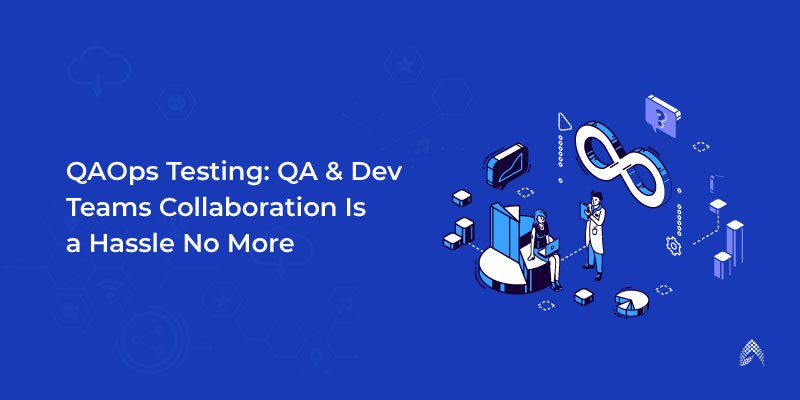How Does QAOps Testing Framework Accelerate Software Delivery

Developers and application testers look at software development from different perspectives, and the lack of coordination between them is often one of the biggest challenges of software product delivery. Developers look at innovative solutions to address a problem. On the other hand, the QA team looks at bugs and defects to ensure the quality of the development process and its results.
In traditional testing, this contradiction between teams can lead to disruptions in processes and deliverables. However, the rapid adoption of agile software QA testing methods is breaking down interdepartmental barriers so everyone can collaborate hand-in-hand.
How do you improve collaboration between your development and testing teams
Oftentimes developers and QA testing teams work independently. They can struggle due to a lack of proper documentation and shared expectations, resulting in poor performance and productivity. Here’s an example of a better way to do it.
Imagine you own a bakery. The chef is preparing a cake; the tester will taste it and give the feedback simultaneously while the manager ensures that no ingredient is missing. This guarantees the cake will be delicious and ready to serve. It’s the same with modern software agile testing methods.
In today’s current competitive market, it is incredibly important that development and QA testing teams work together to ensure high-quality products and performance. This is why organizations are now embracing the QAOps testing framework—to eliminate coordination issues across teams and ensure collaboration instead.
7 Biggest Software Testing Challenges
As a leading software Quality Assurance testing outsourcing company in the USA, Amzur Technologies has identified a few software testing challenges that can hinder the success of an application.
- Undefined quality standards
- Test environment duplication
- Lack of coordination between development and testing teams
- Unstable environment
- Insufficient recruitment gathering
- Lack of technical skills
- Last-minute testing and tight deadlines
Are you struggling with technical glitches and a lack of integration between teams? If so, it’s time to leverage the QAOps framework and ensure that you receive a seamless development and delivery experience.
What is QAOps testing: Quality Assurance + DevOps
Regardless of the size and scale of business, most organizations are moving toward automation. QAOps is a combination of quality assurance testing with DevOps processes. It is essentially a modern software testing method that focuses on application development, improving IT workflow automation, and fixing errors while improving product quality and performance.
Traditionally, QA testing has been an isolated process carried out by post-deployment teams. This often causes delays due to a lack of communication. With QAOps strategy, you can instead seamlessly integrate the testing process into your CI/CD pipeline, working together simultaneously to break the silos.
Explore the top 11 software application testing trends in 2022.
QAOps testing technology is based on two main principles:
- Use of the Continuous Integration, Continuous Testing, and Continuous Delivery (CI/CT/CD) pipeline to ensure better quality and faster delivery.
- QA engineers work in parallel with the development and operations team to speed up delivery and reduce time to market.
What is the CI/CD pipeline in DevOps
Software application development is an evolving process. It involves various steps, including development, testing, releasing, deployment, and compliance checks.
The CI/CD pipeline is an automation process and the backbone of the DevOps approach. A CI/CD pipeline introduces monitoring and automation to improve the software application development process, particularly during integration and testing, deployment, and delivery.
The CI/CD pipeline allows you to develop a software application and integrate its new features continuously through automation testing and timely delivery simultaneously, saving you time and effort.
Implementation of QAOps testing framework
Unlike traditional testing, QAOps software testing is an agile method where different departments work simultaneously to meet deadlines and ensure top-notch product quality. The QAOps testing framework consists of four crucial elements, including:
- Automated testing
- Parallel testing
- Scalability testing
- Integrating DevOps and ITOps with QA
1. Automated testing
In these competitive times, it’s important to understand that application testing has changed significantly in the last decade. Advances in technology have introduced some incredible changes in the way organizations test their applications, and automated testing tools have become prominent due to their ability to save time and improve quality.
As the name denotes, automated testing is a process of leveraging the power of modern technology and tools to minimize human intervention and efforts. In this stage, your QA team analyzes the whole project and decides which parts of the testing process need automation. Automation testing also helps you reduce bugs and improve the end-user experience.
At Amzur, we use the following automation testing tools to ensure our client’s product is bug-free and delivered on time.
- Automation (Web Applications) – Selenium 4.0 Upgrade/Java 10 Cucumber 3.1.2/Python
- Automation (Mobile Applications) – Appium 1.7
2. Parallel testing
Testing an application is not like a relay race, where you wait until someone comes to hand over the baton. Instead, every stage has a ripple effect on overall performance and delivery.
Parallel testing allows you to test components concurrently to save time and effort. You can conduct parallel testing at scale by using advanced tools or threads designed to run multiple tests simultaneously. The main benefit of parallel testing in the QAOps framework is that it accelerates execution across multiple versions.
Parallel testing is hardware-sensitive and requires high-performing computers and architecture for implementation.
Here are some parallel testing tools that you can use to improve performance.
- Selenium
- TestComplete
- BitBar by Smartbear
- TestProject
- Katalon Studio
- Perfecto by Perforce
3. Scalability testing
The third crucial element of the QAOps framework is scalability testing. Once your product is live, it is essential that you check its performance, refine existing features, and add new features to ensure the application delivers seamless performance under various loads and requests.
Scalability testing evaluates an application’s behavior when it is scaled up or down based on the number of user requests at any given time. For example, Facebook is one of the leading social media giants worldwide. It has massive load fluctuations during morning and night times.
Therefore, the QA team has to conduct a scalability test to check whether it can handle the traffic or not. When scalability testing has become a part of the CI/CD pipeline, the software QA testing team can understand the performance-related challenges and revamp the existing application’s features.
4. Integrating DevOps and ITOps with QA
As discussed previously, QA testing is no longer an isolated process. With the evolution of the QAOps testing framework, it has become easy for organizations to bring QA, development, and IT teams to work together to break the communication silos.
In QAOps architecture, QA becomes part of the CI/CD pipeline, allowing developers and QA experts to understand the functionality of an application and eliminate bugs to improve the end-user experience.
Benefits of the QAOps Testing Process
There are five main benefits to be had by your organization embracing the QAOps testing framework.
- The first and foremost benefit of the QAOps process is the quality of the product. As QA teams work with the software delivery pipeline, fixing and identifying bugs and improving quality will become easier.
- Meeting deadlines and a reduced time to market are other benefits of the QAOps testing framework. Because there is a high level of collaboration among QA teams, development, and IT teams, they can quickly detect challenges and release new versions as solutions.
- QAOps testing saves a lot of money compared to traditional application testing. When the QA team works closely with the development team, they can detect bugs early and fix them before it burns through the testing budget.
- Concurrency is another benefit of the QAOps framework. You can conduct various element testing in parallel without any delays. This has a significant impact on resource utilization and project delivery.
- A happy customer is the ultimate goal of any technology or tool. QAOps testing ensures an improved customer experience while guaranteeing scalability and security.
Life Cycle of QAOps Framework
QAOps software testing is all about choosing the best automation testing tools and integrating them throughout the CI/CD pipeline to ensure the newly built code is tested and validated. The QAOps framework is built on three factors:
- Trigger
- Execute
- Report
1. Trigger
Application development and validation is a continuous process. Therefore, your QA team needs to trigger relevant test models whenever there is a change at a functional level in the CI/CD pipeline. On the other hand, triggering irrelevant tests will waste your time and might lead you to miss critical testing areas.
That’s why it is essential to map functionalities with automated tests to ensure the testing process is smooth and error-free. If this step goes well, the entire team will have increased confidence and be ready to move forward.
2. Execute
Another crucial aspect of the QAOps testing framework is the execution part. Once you trigger relevant tests at the functionality level, it is essential to run tests in parallel to save time and generate faster results.
For this, you need a high-performing infrastructure that can scale with your requirements. And to avoid process disruptions, make sure continuous testing in the DevOps environment is highly available.
3. Reports
Reporting is the most important aspect of the QAOps testing framework. You must have quick, on-demand access to test reports to analyze what’s working and what didn’t work well. This allows you to immediately make necessary changes to avoid bugs and improve quality.
Conclusion
Is your QA expert team idle and waiting until the project is ready?
Did you find any communication silos between your development and QA teams?
No worries.
Consider embracing the QAOps testing framework for your organization to gain the upper hand over your competitors in the software development industry.
QAOps has evolved as the next biggest thing to consider in the software testing discipline, and many companies are already on their way to embracing this modern QA testing technology.
Want to improve collaboration among your teams and achieve faster time to market without any quality compromises?
Talk to our experts to know more about QAOps testing framework.

Head of Quality Engineering




